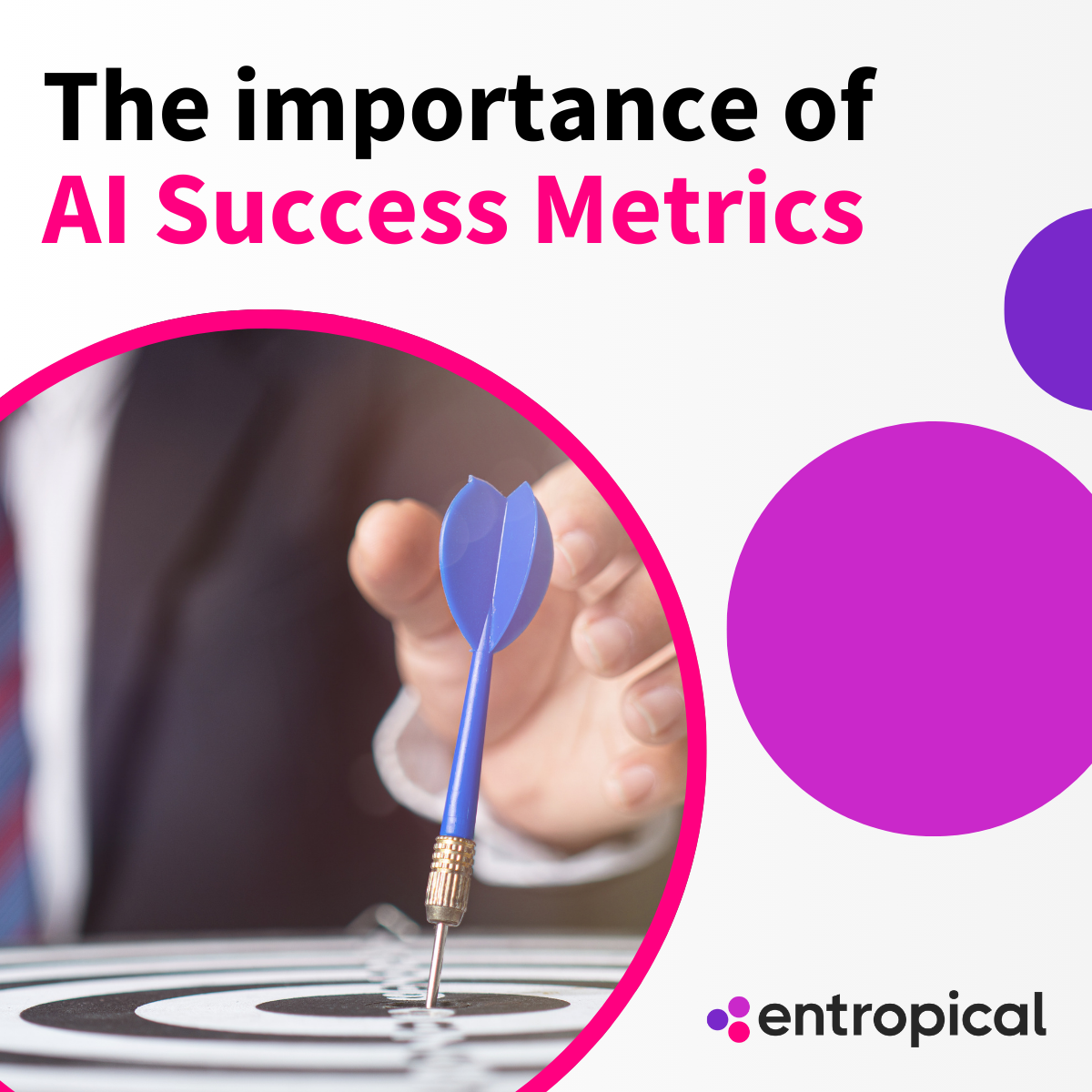
Defining AI Success Metrics
Defining Success: Key Metrics for Effective AI Integration
Why establishing clear KPIs is crucial when implementing AI in e-commerce and digital marketing.
Integrating Artificial Intelligence (AI) into your business operations promises transformative benefits—from enhancing customer experiences to streamlining processes and reducing manual workloads. However, without clear metrics to define what success looks like, AI initiatives can become directionless, leading to wasted resources and unmet expectations.
At Entropical, we emphasize the importance of setting well-defined Key Performance Indicators (KPIs) before embarking on any AI project. Establishing clear metrics ensures that all stakeholders have a unified understanding of project goals and provides a roadmap for measuring progress and success.
The Importance of Clear Metrics in AI Integration
Aligning with Business Objectives
Setting clear KPIs aligns AI initiatives with your overall business goals. Whether aiming for better customer satisfaction, increased operational efficiency, or cost reduction, KPIs ensure that your AI solutions are designed to deliver measurable outcomes that support your strategic objectives.
Enhancing Accountability and Transparency
Clear metrics foster accountability among team members and stakeholders. They provide a transparent framework for evaluating performance, making it easier to identify areas of success and those needing improvement.
Optimizing Resource Allocation
By defining success upfront, you can allocate resources more effectively. Understanding what you aim to achieve allows for better planning, budgeting, and resource management throughout the AI integration process.
Common Pitfalls of Undefined Success Metrics
Too often, businesses dive into AI integration without a concrete understanding of what they hope to accomplish. This can lead to:
- Misaligned Expectations: Without clear goals, different stakeholders may have conflicting views on what success looks like.
- Inefficient Use of Resources: Time and money may be spent on features or capabilities that don’t contribute to meaningful outcomes.
- Difficulty in Measuring Impact: Without predefined metrics, it’s challenging to assess whether the AI initiative is delivering value.
Key Metrics to Measure the Success of AI Initiatives
Here are essential KPIs that can help gauge the effectiveness of AI integration in e-commerce and digital marketing:
1. Customer Satisfaction Score (CSAT)
Measuring Improvements in Customer Experience
AI technologies like chatbots, personalized recommendations, and automated support can significantly impact customer satisfaction.
- How to Measure: Use surveys, feedback forms, or rating systems post-interaction to gather customer feedback.
- Why It Matters: An increase in CSAT indicates that AI is positively enhancing the customer experience, leading to higher retention and loyalty.
2. Operational Efficiency
Tracking Time Savings and Resource Optimization
AI can automate repetitive tasks, optimize workflows, and improve process efficiency.
- How to Measure: Compare the time and resources required to perform tasks before and after AI implementation.
- Why It Matters: Improved efficiency can reduce operational costs and free up employees to focus on higher-value activities.
3. Error Rate Reduction
Monitoring Decreases in Mistakes and Inaccuracies
AI systems can reduce human errors in areas like data entry, order processing, and customer service.
- How to Measure: Track the frequency of errors or defects over time.
- Why It Matters: Fewer errors lead to cost savings, improved quality, and enhanced customer trust.
4. Response Time
Evaluating Speed in Resolving Customer Queries
AI-powered chatbots and support systems can provide instant responses to customer inquiries.
- How to Measure: Calculate the average time taken to respond to customer requests before and after AI deployment.
- Why It Matters: Faster response times improve customer satisfaction and can increase conversion rates.
5. Cost Savings
Calculating Reductions in Operational Expenses
Implementing AI can lead to significant cost reductions by automating processes and improving efficiency.
- How to Measure: Analyze operational costs before and after AI integration, considering factors like labor, materials, and overhead.
- Why It Matters: Cost savings directly impact the bottom line, improving profitability.
Implementing Clear Metrics: A Collaborative Approach
Engage Stakeholders Early
Work with all relevant stakeholders—management, IT, marketing, customer service—to identify which metrics are most important to your organization.
Set Realistic and Measurable Goals
Ensure that KPIs are Specific, Measurable, Achievable, Relevant, and Time-bound (SMART). This makes it easier to track progress and make necessary adjustments.
Regularly Monitor and Adjust
Establish a routine for reviewing KPIs to assess performance. Be prepared to adjust strategies based on the data to continually improve outcomes.
The Role of KPIs in E-commerce and Digital Marketing
In the context of e-commerce and digital marketing, clear metrics are vital for:
- Personalization Efforts: Measuring the effectiveness of AI in delivering personalized experiences.
- Customer Engagement: Tracking how AI impacts customer interaction rates across platforms.
- Marketing ROI: Assessing the return on investment from AI-driven marketing campaigns.
Additional Metrics to Consider
While the above KPIs are foundational, consider these additional metrics to gain deeper insights:
6. Conversion Rate Improvement
Assessing the Impact on Sales and Lead Generation
- How to Measure: Monitor the percentage of visitors who take a desired action (e.g., make a purchase, sign up for a newsletter).
- Why It Matters: Higher conversion rates indicate that AI is effectively engaging customers and driving actions.
7. User Adoption Rate
Measuring Employee and Customer Engagement with AI Tools
- How to Measure: Track the number of users actively engaging with AI systems over time.
- Why It Matters: High adoption rates suggest that the AI tools are user-friendly and valuable.
8. Return on Investment (ROI)
Evaluating Financial Gains Relative to Investment
- How to Measure: Calculate the net profit from AI initiatives divided by the total cost of investment.
- Why It Matters: Demonstrates the financial viability and success of AI projects.
Example Case Study: Successful KPI Implementation
Background
An online fashion retailer aimed to increase sales and enhance customer experience by implementing an AI-powered personalized product recommendation system.
KPIs Set
- Conversion Rate Improvement: Increase the conversion rate from product recommendations by 15% within six months.
- Average Order Value (AOV): Boost the AOV by 10% through effective cross-selling and upselling.
- Customer Engagement: Increase click-through rates on recommended products by 20%.
- Customer Satisfaction (CSAT): Maintain or improve the CSAT score, ensuring that personalized recommendations enhance the shopping experience.
Results
- Conversion Rate Improvement: Achieved a 17% increase in conversions from recommended products, surpassing the target.
- Average Order Value: AOV increased by 12%, indicating successful upselling and cross-selling.
- Customer Engagement: Click-through rates on recommended products rose by 22%.
- Customer Satisfaction: CSAT scores remained steady at 90%, with positive feedback on the relevance of recommendations.
Conclusion
By setting clear KPIs, the retailer was able to measure the success of its AI-powered recommendation system effectively, make informed decisions, and realize tangible benefits in sales and customer satisfaction.
Conclusion
Defining clear metrics for success is essential when integrating AI into your business. It ensures that your initiatives are goal-oriented, measurable, and aligned with your overall strategy. At Entropical, we specialize in helping businesses establish and achieve meaningful KPIs, leveraging AI to drive measurable success in e-commerce and digital marketing.
What Metrics Do You Use to Gauge the Success of Your AI Efforts?
We invite you to reflect on the KPIs that matter most to your organization. Are you focusing on customer satisfaction, operational efficiency, cost savings, or perhaps a combination of several metrics?
Ready to Define Success Together?
If you’re looking to implement AI solutions with measurable outcomes, contact us at Entropical. Let’s work together to establish clear KPIs and ensure your AI integration delivers the success your business deserves.



